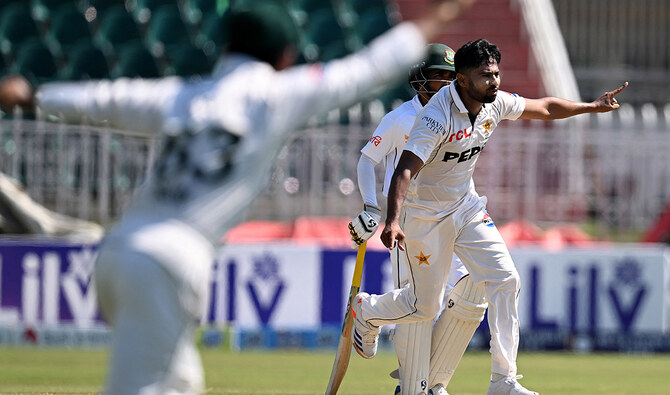RAWALPINDI: Liton Das hit a fighting hundred to lift Bangladesh from a precarious 26-6 to 262 all out on Sunday, in a remarkable turnaround that left the second Test in Rawalpindi within either team’s grasp.
The 29-year-old hit 138 over the course of a marathon 333 minutes and brought Bangladesh back into the match with a fighting 165-run seventh-wicket stand alongside Mehidy Hasan Miraz, who scored a pugnacious 78.
At close on the third day, Bangladesh struck back to leave Pakistan on a sluggish 9-2, with opener Abdullah Shafique dismissed for three and nightwatchman Khurram Shahzad falling without scoring — both to pacer Hasan Mahmud.
Saim Ayub was not out on six as the home team lead by 21 runs, and Pakistan will need to bat smartly to clinch a series-levelling win after losing the first Test, also in Rawalpindi, by 10 wickets.
Bangladesh’s win last week was their first in 14 attempts against Pakistan.
The highlight of the day was Das and Mehidy’s match-turning stand.
On top of that, Das added 69 with tail-ender Mahmud (13 not out) in a 24.5-over ninth wicket stand, equalling the partnership record against Pakistan and leaving the home team frustrated.
Das, dropped on 90 by spinner Abrar Ahmed off his own bowling, hit a late cut off the same bowler to reach his fourth Test hundred. He finally holed out to Agha Salman at long-on.

Bangladesh’s Litton Das celebrates after scoring century during the third day of second test cricket match between Pakistan and Bangladesh, in Rawalpindi September 1, 2024. (AP)
Das, who came to the crease with Bangladesh tottering at 26-5, cracked 13 boundaries and four sixes, adding a big 236 for the last four wickets.
Earlier, Pakistan were put in a strong position by pacer Shahzad’s career-best 6-90 and Mir Hazma (2-50) in the morning session, but they were left wanting thereafter.
Das and Mehidy’s solid stand took advantage of an eased-out Rawalpindi stadium pitch in the second session of the rain-affected Test, which saw Friday’s first day washed out.
Shahzad, who had taken 4-15 in his first spell, had Mehidy caught and bowled off a miscued drive two overs before tea to end Pakistan’s long and frustrating wait for the seventh wicket.
Das and Mehidy are the first pair in Tests to add 150 or more runs for the seventh or lower wicket from a team total under 50 runs.
Mehidy, who took 5-61 on Saturday, hit 12 boundaries and a six as he passed 50 for the eighth time in Tests.

Bangladesh's Hasan Mahmud, third right, celebrates with teammates after taking the wicket of Pakistan's Abdullah Shafique during the third day of second test cricket match between Pakistan and Bangladesh, in Rawalpindi on September 1, 2024. (AP)
Bangladesh resumed at the start of the day on 10-0, but Shahzad soon had opener Zakir Hasan caught by Abrar Ahmed at short midwicket for one in the fourth over.
Shahzad then bowled Shadman Islam (10) and skipper Najmul Hossain Shanto (four) in the space of four deliveries to reduce Bangladesh to 20-3.
At the other end, Hamza had Mominul Haque caught by Mohammad Ali at mid-on for one and then removed first Test centurion Mushfiqur Rahim for three, caught behind by Mohammad Rizwan from a beautiful outswinger.
Shahzad made it 26-6 by trapping Shakib Al Hasan lbw for two before Mehidy and Das dug in.
Shahzad’s previous best figures were 3-45 in his debut Test against Australia at Perth last year.
















